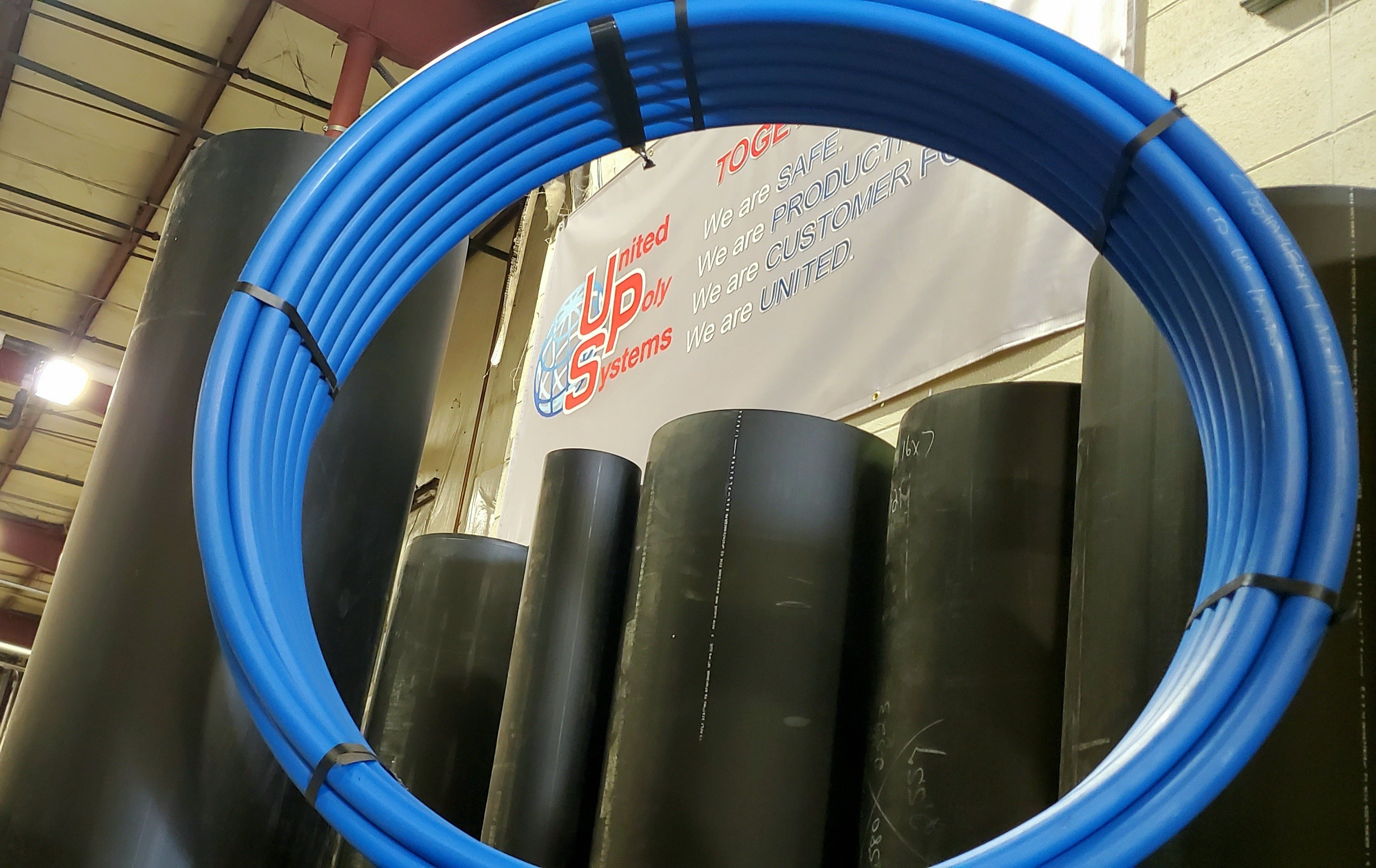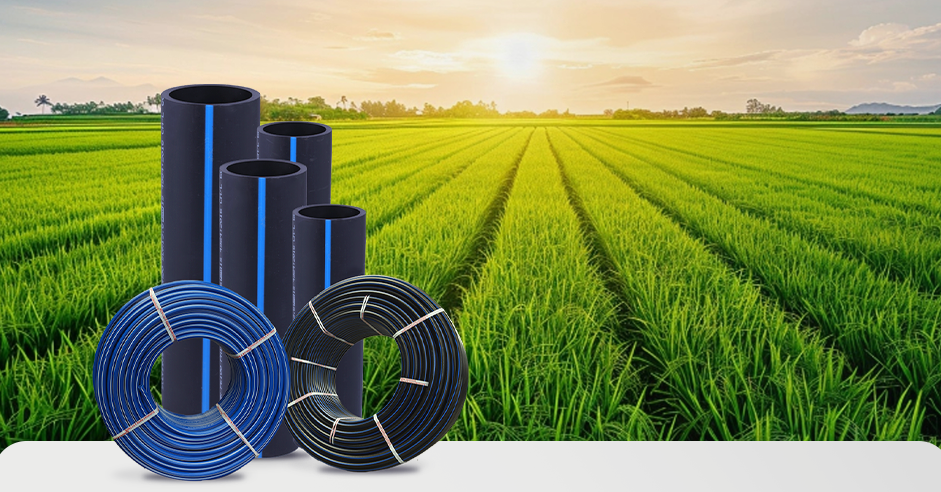Explore the Manufacturing Process Behind High-Quality HDPE Pipe and Its Applications
The manufacturing process of premium HDPE pipes is detailed and methodical. It starts with the choice of resources that improve performance. Following this, ethylene undergoes polymerization to develop resin, which is then formed through extrusion. Quality assurance is extremely important, ensuring that the final item meets rigorous requirements. However, the journey of HDPE pipelines does not end with production. Their applications throughout various markets expose a more comprehensive value worth taking a look at.
Recognizing HDPE: Residences and Advantages

High-density polyethylene (HDPE) is a versatile thermoplastic recognized for its durability and resistance to numerous ecological factors. This product displays outstanding tensile toughness, making it suitable for requiring applications. Its low-density structure adds to a light-weight item, assisting in convenience of dealing with and installment. HDPE likewise showcases remarkable resistance to chemicals, which lessens deterioration when subjected to extreme substances.
The product's low wetness absorption even more improves its long life, making it perfect for usage in pipelines and storage containers. Additionally, HDPE is immune to ultraviolet (UV) radiation, ensuring that items preserve their honesty also when exposed to sunshine. Its versatility enables for the production of intricate shapes without jeopardizing toughness. The environmentally friendly nature of HDPE, commonly originated from recycled materials, contributes to its appeal, advertising sustainable practices in manufacturing. On the whole, these residential or commercial properties and benefits make HDPE a recommended selection for various industrial and consumer applications.
Raw Material Option for HDPE Production
The option of raw products for HDPE production is essential to verify the end product fulfills the desired specifications and high quality criteria. High-density polyethylene (HDPE) is mainly created from polymerized ethylene, stemmed from nonrenewable fuel sources such as gas or crude oil. The high quality of these feedstocks greatly affects the mechanical and thermal properties of the final HDPE.
Additives additionally play a significant duty in enhancing HDPE's efficiency, including anti-oxidants, UV stabilizers, and colorants, which improve resilience and resistance to ecological variables. The selection process need to consider not only the chemical composition of the raw materials however likewise their processing features to guarantee reliable manufacturing.
The sourcing of raw products should prioritize sustainability and compliance with ecological guidelines, as responsible techniques are necessary in today's market. Inevitably, cautious raw material choice lays the structure for creating high-quality HDPE pipelines ideal for varied applications.
The Extrusion Refine: Shaping HDPE Pipeline
The extrusion process plays a crucial duty fit HDPE pipelines, beginning with meticulous product prep work strategies that assure perfect circulation and uniformity. Just as vital is the style of the die, which straight affects the last measurements and surface top quality of the pipeline. Together, these elements add substantially to the efficiency and quality of HDPE pipeline production.
Material Prep Work Strategies
Effective production of HDPE pipelines begins with careful material preparation methods, particularly the extrusion procedure. During this stage, high-density polyethylene resin is initial dried out to get rid of wetness, guaranteeing suitable circulation characteristics. The material is then fed into the extruder, where it goes through heating and melting, transforming right into a viscous state. This home heating process is thoroughly controlled to maintain the material's stability and performance. The molten HDPE is required via a die, forming it into a continuous pipe form. Proper temperature management during extrusion is essential, as it directly influences the product's residential or commercial properties and the end product high quality. Once formed, the HDPE pipeline is cooled down and reduced to specified lengths, all set for succeeding processing and applications.
Die Design Value
Precision in die design plays an important role in the extrusion process of HDPE pipelines. The die functions as the final shaping device, directly influencing the pipe's measurements, wall thickness, and surface area coating. A well-designed die assurances uniform product flow, minimizing problems such as abnormalities and weak places. The geometry of the die need to be optimized to suit the certain homes of HDPE, including its viscosity and thermal habits during extrusion. Furthermore, the cooling price of the material as it travels through the die can significantly influence the pipeline's architectural stability. Consequently, purchasing advanced die innovation is essential for producers intending to create top quality HDPE pipes that satisfy industry requirements and consumer expectations.
High Quality Control Measures in HDPE Manufacturing
Although numerous elements influence the high quality of HDPE pipeline manufacturing, efficient top quality control steps are important to assure uniformity and reliability in the end product. Secret high quality control practices include extensive material inspection, verifying that the raw polyethylene fulfills recognized requirements for purity and density. Throughout the extrusion procedure, criteria such as temperature level, stress, and cooling time are carefully kept track of to maintain dimensional precision and architectural honesty
On top of that, post-production screening is essential; producers frequently conduct hydrostatic tests to analyze the pipe's strength and resistance to pressure. Aesthetic assessments for surface flaws additionally improve quality guarantee. Certification from relevant requirements organizations, like ASTM or ISO, provides an added layer of credibility. By applying these extensive quality assurance measures, suppliers can lessen flaws, boost performance, and ensure that the HDPE pipelines satisfy the particular demands of different applications, ultimately bring about client complete satisfaction and depend on in the product.
Applications of HDPE Pipeline Across Industries
HDPE pipelines are used throughout various fields because of their sturdiness and flexibility. In water circulation systems, they ensure efficient distribution, while in wastewater management, they offer dependable solutions for waste transportation. Additionally, agricultural watering networks benefit from HDPE's resistance to deterioration and versatility, making it an ideal option for modern farming methods.

Water Distribution Systems
A considerable variety of markets rely on high-density polyethylene (HDPE) pipes for reliable water distribution systems. Understood for their sturdiness and resistance to corrosion, HDPE pipelines are extensively used in municipal supply of water networks, agricultural watering, and industrial applications. Their lightweight nature promotes simple handling and setup, decreasing labor costs and time. In addition, HDPE pipes can accommodate different stress degrees, making them suitable for both reduced and high-pressure systems. hdpe pipe in stock Midland TX. The adaptability of the product enables seamless assimilation right into existing infrastructure, minimizing the demand for substantial excavation. HDPE's resistance to chemical leaching assurances that the water delivered remains secure and clean, making it an ideal choice for maintaining the quality of safe and clean water across different industries.
Wastewater Administration Solutions
Efficient water distribution systems also lead the way for innovative wastewater management solutions, where high-density polyethylene here (HDPE) pipes play a considerable duty. Prominent for their durability and resistance to corrosion, HDPE pipelines are suitable for transporting wastewater in various settings. Their adaptability enables for simple installation in complicated atmospheres, reducing the need for extensive excavation. Additionally, HDPE's smooth indoor surface lowers rubbing, improving flow prices and performance. These pipelines are also immune to chemical leaching, making sure that pollutants do not compromise the surrounding setting. Industries, municipalities, and therapy facilities significantly depend on HDPE pipes for their reliability and longevity, making them a favored choice for modern-day wastewater administration systems. This versatility highlights the crucial significance of HDPE pipelines across countless applications.
Agricultural Watering Networks
Agricultural watering networks profit substantially from using high-density polyethylene (HDPE) pipelines, which offer efficient and reputable water distribution to crops. HDPE pipelines are lightweight, making them simple to transfer and install, while their versatility permits various arrangements in diverse surfaces. These pipes show outstanding resistance to rust, chemicals, and UV radiation, ensuring toughness in extreme agricultural atmospheres. In addition, their smooth interior surface decreases rubbing loss, maximizing water flow and minimizing power costs related to pumping. The durability of HDPE pipelines, often surpassing half a century, adds to lower upkeep and substitute expenditures. Farmers increasingly depend on HDPE pipes to improve watering performance and advertise lasting farming techniques, inevitably leading to boosted crop yields and source preservation.

Future Patterns in HDPE Pipeline Innovation
As the need for lasting and efficient framework grows, improvements in HDPE pipeline innovation are positioned to transform different sectors. Emerging patterns include the combination of clever innovations, such as sensing units and IoT capacities, which facilitate real-time tracking of pipeline problems, reducing maintenance prices and preventing leakages. In addition, the development of advanced manufacturing methods, such as 3D printing, is making it possible for the production of complex, customized pipe styles that deal with details project requirements.
Additionally, the concentrate on recycling and circular economic climate methods is driving the technology of HDPE pipelines made from recycled materials, improving sustainability. Improved jointing techniques, such as electro-fusion and mechanical installations, are additionally boosting installment efficiency and reliability. The growing emphasis on environmental policies is pushing manufacturers to take on greener manufacturing procedures, making sure that HDPE pipelines not only satisfy industry criteria yet likewise cultivate a more sustainable future for infrastructure growth.
Often Asked Concerns
Exactly How Does HDPE Compare to Other Plastic Products?
HDPE outmatches several various other plastic materials concerning resilience, chemical resistance, and flexibility. Its reduced density and high tensile strength make it excellent for various applications, usually going beyond options in both efficiency and durability.
What Are the Environmental Impacts of HDPE Manufacturing?
The environmental influences of HDPE production consist of greenhouse gas discharges, energy usage, and possible contamination from manufacturing procedures. Additionally, improper disposal can lead to dirt and water contamination, raising problems regarding lasting eco-friendly results.
Can HDPE Pipes Be Reused?
Yes, HDPE pipes can be reused. Many centers approve utilized HDPE for handling, transforming it right into new items. This recycling adds to sustainability efforts, reducing plastic waste while conserving resources and energy in the production cycle.
What Is the Lifespan of HDPE Water Lines?

How Do Temperature Level Variations Affect HDPE Pipe Efficiency?
Temperature variants considerably impact HDPE pipeline performance, affecting adaptability and strength. High temperature levels can cause softening, while low temperature levels might trigger brittleness, ultimately affecting the pipe's durability and viability for various applications in varied atmospheres.